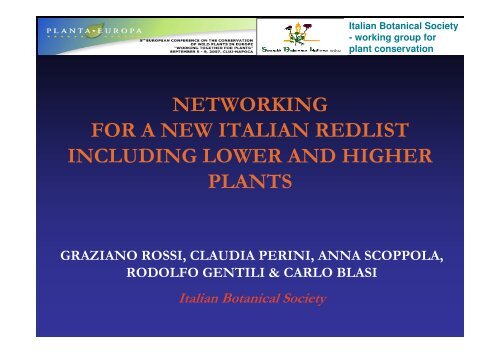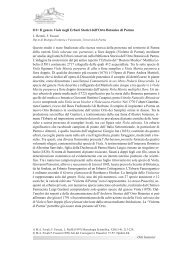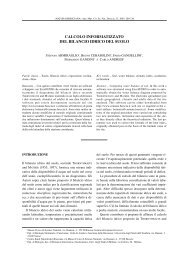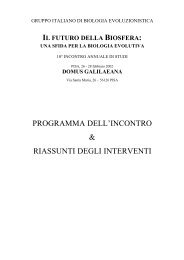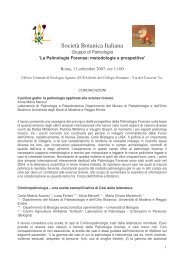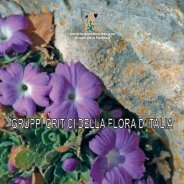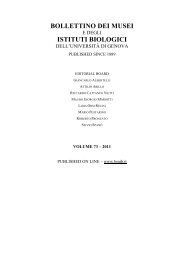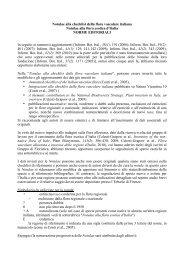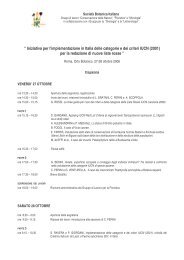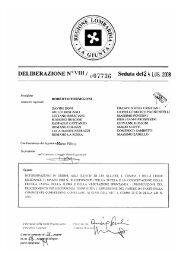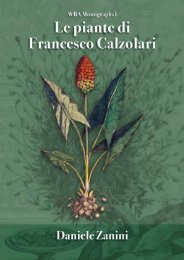Italian Botanical Society - Società Botanica Italiana
Italian Botanical Society - Società Botanica Italiana
Italian Botanical Society - Società Botanica Italiana
Create successful ePaper yourself
Turn your PDF publications into a flip-book with our unique Google optimized e-Paper software.
<strong>Italian</strong> <strong><strong>Botanica</strong>l</strong> <strong>Society</strong>- working group forplant conservation
!"#$"%"& '()**)+ EPCS Targets<strong>Italian</strong> <strong><strong>Botanica</strong>l</strong> <strong>Society</strong>- working group forplant conservation1.1 Working list of all known European plant species(including cryptogamic plants and fungi) produced1.2 European Red List for vascular plants, revised list forbryophytes, and preliminary Red Lists for lichens,macrofungi and other selected groups publishedREVISED TARGET (2004) BY 2007:All national endemic vascular plant species included in theIUCN red list
<strong>Italian</strong> <strong><strong>Botanica</strong>l</strong> <strong>Society</strong>- working group forplant conservation,$$!"#!"$')**-(./0 !"# !"$#",!, 1 , $$ 2"%$!"2"+13", ')**)( "0 ')**4( " " ')**5(,!6 ')**5( !708!"&')**5( #"!$')**9(.":$#"&"$$+!$" " # %:#..
<strong>Italian</strong> <strong><strong>Botanica</strong>l</strong> <strong>Society</strong>- working group forplant conservation,$$$$:&2!#,,,$2";$1$#!8$;,)**-'&.(2"+.-
9A decadeof dirtinessIn the last ten years there’s been a huge hike in the amount oflitter found on UK beaches – it’s gone up over 20%.Our graph clearly shows the ten year trend.Sadly most of the litter we find on beaches can be traced back to the general public.But there is good news – compared to other sources of litter – the percentage ofpublic litter has gone down over the last two years. However the volume hasincreased – so we’re finding more items in every kilometre cleaned.2,500PUBLICPLASTIC PIECESNON SOURCEDFISHING LITTERSEWAGE RELATED DEBRISSHIPPING LITTERFLY TIPPEDWe love our plastic stuff – it’s tough, comes in all different shapesand sizes and when it’s not needed anymore we just chuck it away.What’s not to like? Trouble is it gets smaller and smaller and endsup on our beaches and the more we love plastic – the more wefind. We need to change our behaviour – find out how overleaf.Fishing litter is a regular find on our beaches. Anglers love the coast and althoughsome deliberately ditch line and hooks, most will accidentally lose their kit or leaveit behind. Thanks to our ‘Hang on to your Tackle’ campaign there’s beenan increased awareness of the need to dispose of fishing litter safely.Our beaches are a magnet for fly-tipping – in fact fly tipped items haveincreased since 2013. These items are generally pretty big stuff, sonot only dangerous to beach visitors but a real eyesore.2,5002,0002,0001,5001,5001,0001,000500500 20052006 2007 2008 20092010 2011 2012 2013 2014
<strong>Italian</strong> <strong><strong>Botanica</strong>l</strong> <strong>Society</strong>- working group forplant conservation%Since 2006 key groups S.B.I. havebeen working together assessing theconservation status of 40 target speciesof the <strong>Italian</strong> native flora, includingvascular, non vascular, fungi andlichens in order to promote a new<strong>Italian</strong> Red List, 6 years after the lastupdate, and the first time enlarged tothe whole old Regnum PlantaeViola comolliaPleurotus nebrodensis
<strong>Italian</strong> <strong><strong>Botanica</strong>l</strong> <strong>Society</strong>- working group forplant conservation70#2##- EOO = 1100 Km 2Sanguisorba dodecandra Moretti- AOO = 516 Km 2-Location = 19-Threats = new dykesunder construction andclimatic changeIUCN Category 2001: Near ThreatenedGISdatabaseEOO < 5000 Km2 B1a(b)In Red List 1997: Lower Risk
1) Potentiality@ !$$a) plenty of floristic data are generally available forvascular plants (Criteria B and A, D)<strong>Italian</strong> <strong><strong>Botanica</strong>l</strong> <strong>Society</strong>- working group forplant conservationb) many botanists are active in the field and agreed withenthusiasm: good possibilities for networking !2) Problems of application:a) few information available for fungi and lichensb) survays in the field are required in many casesc) unsolved taxonomic problemsd) demographic data are rarely available
<strong>Italian</strong> <strong><strong>Botanica</strong>l</strong> <strong>Society</strong>- working group forplant conservation;1,$?2")*-*?It is hoped that this first contributionwill open the way to the production ofa new red list of the <strong>Italian</strong> Flora, withthe support of EU, national and localgovernment authorities.
"0"2"0www.societabotanicaitaliana.it<strong>Italian</strong> <strong><strong>Botanica</strong>l</strong> <strong>Society</strong>- working group forplant conservationIniziative per l’implementazione inItalia delle categorie e dei criteriIUCN (2001)
NEW EPCS targets<strong>Italian</strong> <strong><strong>Botanica</strong>l</strong> <strong>Society</strong>- working group forplant conservation-(,"$,&,,!0&#,%"$whatAll national endemic vascular plantspecies included in the IUCN globalRed List (to be concluded)Integrate all ongoing iniziatives (fromregional to EU-biogeographical level)Lobbing for revision of H. Dir.; adoptionof new legislation for flora protection;by201020132010whoPE members & otherconservation inst.
<strong>Italian</strong> <strong><strong>Botanica</strong>l</strong> <strong>Society</strong>- working group forplant conservationSileneelisabethaeTHANKS YOUFOR YOURATTENTION !


